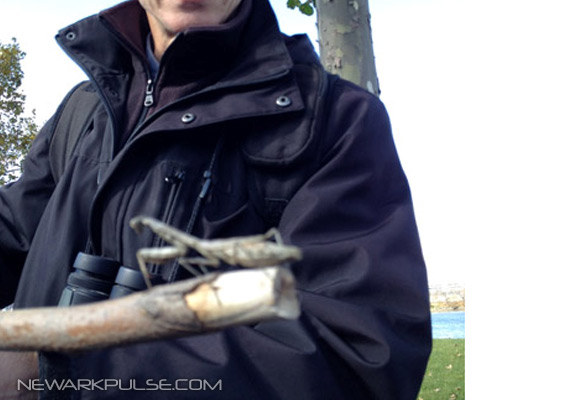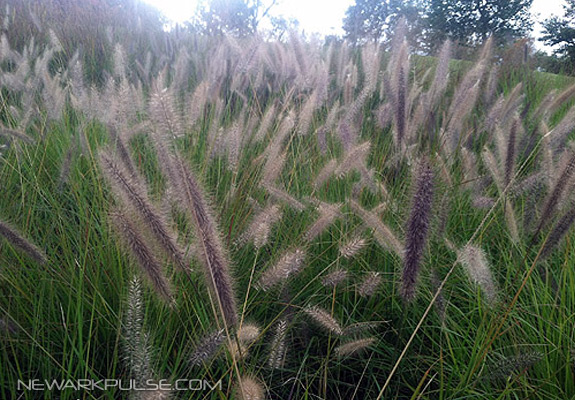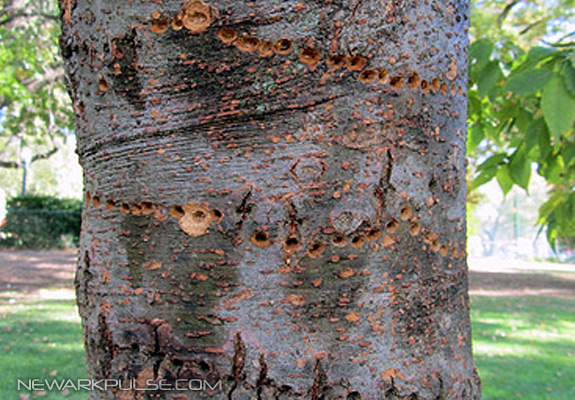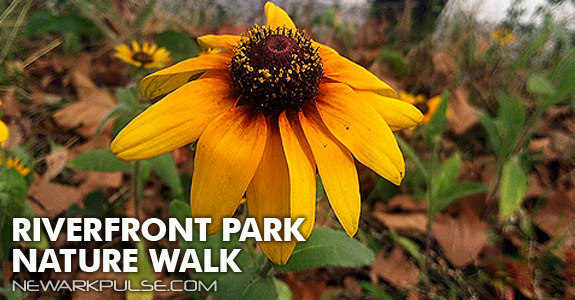Riverfront Fall Nature Walk 2013
Blue skies over the Passaic River and crisp autumn air welcomed us to Riverfront Park on a recent fall day. Once considered one of the most seriously contaminated Superfund sites in the nation, this section of Newark's waterfront has recently been cleaned up, redesigned with walkways and sculptures, and restored with many new plantings thanks to the public and private fundraising efforts of The Trust For Public Land. Since this was my first visit to the 4-acre park, I was curious to see what surprises awaited. I didn't have to wait long. Upon crossing Raymond Blvd to enter the park, I bent down to pick up a freshly fallen sugar maple leaf. My eyes fixed on something else. There, sitting in the middle of the path was a large praying mantis. Using a stick, I gently picked up this remarkable insect and placed it safely in the grass off the pedestrian path. In the autumn the female lays her eggs "” often in a hidden place such as in a fence, or wall or on a tree branch or plant stalk. My guess is that this was a female in the process of doing just that.

The praying mantis is so named because of its large pair of folded front legs. Although it may appear as if this creature is praying, these specialized legs with wide, spike like clasps for grasping its food, is actually "preying." Because its feeds on many insects considered to be pests, the praying mantis is a beneficial insect to have around the garden or farm. The discovery of this unusual creature was a nice way to begin our walk.
There were a number of fresh plantings along the landscaped walkway. The young trees included Red Oak, Pin Oak, and a form of white birch, which appeared to be Whitebarked Himalayan Birch (Betula utilis). There were also a good number of colorful Sugar Maples and Red Maples planted nearby. Beginning in October, maples provide some of the most spectacular autumn foliage. Each year I eagerly wait and watch as both of these tree species seem to compete to see which will produce the most brilliant fall colors.
As we walked along the river, I noticed a yellow butterfly flying low over an area of fresh grass. Without the benefit of a closer look, it appeared to be a sulfur, most likely a species of clouded sulfur. Sulfurs are the delicate little yellow butterflies that you often see near the ground around puddles in the summer time. I thought the sighting was interesting as this is getting a little late in the season for this species. One of the probable reasons of course was the variety of wildflower plantings "” many still in bloom "” that were growing along the paths and down the riverbank. These included Asters, Golden Tickseed, and Black-eyed Susans, some of which were still actively producing pollen.
Several of the shrubs that are planted at Riverfront Park receive high marks for being environmentally sustainable. Hobblebush viburnum, and winterberry for example are enjoyed by many fall migrants as well as year-round birds for the seasonal sustenance they provide in the form of berries throughout the fall and winter. A variety of other decorative plantings were arranged as borders along grass lawns and pathways. These included mapleleaf viburnum, oakleaf hydrangea, and foxtail grass (which swayed beautifully in the wind).

Out on the river we spied some male and female mallard ducks and a number of ring-billed gulls. A low-flying double-crested cormorant passed by and then another came in for a landing in the middle of the Passaic. These large waterfowl dive for fish which they catch with their sharp, hooked bills. You can often see them standing on a branch with their wings spread open, drying them after a lengthy fishing session. A noteworthy surprise was a Belted Kingfisher which we startled on the shore below us. This blue, colorful bird with an over-sized head and bill also dives beneath the surface for fish. It flew to the other side of the river where it perched on a bare branch so we could admire its features from a distance. The presence of both of these species is a strong indicator that although it still is polluted from years of abuse, the Passaic may be on the rebound as it manages to still maintain enough marine life to support certain bird species.
Further upstream we came to an area that ran wild with older, established plants and trees. It was interesting to note that while the planted and landscaped areas included almost exclusively all native plants (which has become the standard choice of landscape design these days), this area was overgrown with many more "wild" non-native species. Here were several large Siberian Elms growing along the river. Norway maples "” rather than the native red and sugar maples "” were also present. And what is considered a highly invasive species, Japanese Knotweed, had also established itself along the river. Suddenly a small flicker of life hopped from branch to branch in the Siberian Elms. It was a tiny bird, a migrant called a Ruby-crowned Kinglet that was putting on an aerial display while searching for tiny insects (and their eggs) hidden among the leaves and bark. We saw one, and then another of this species.
Also along this wild area, we spotted a large tree covered with hundreds, perhaps thousands of long, brown, paddle-shaped seedpods. It was a White Ash, a hearty native tree whose hard wood is used to make baseball bats, hockey sticks, and all sorts of tools and furniture. Another interesting tree planted along Raymond Blvd and the river is the London Planetree. This is the tree whose bark peels off in strips of grey, green, tan and brown that give its surface a mottled, camouflage look. It is a hybrid of the American Sycamore and the Oriental Sycamore that originated in London around 1637.
Returning to where we began at the Riverbank Park recreational field area, we noticed a number of White-crowned sparrows mixed in on the ground with our common year-round House sparrows. The White-crowned are migrant birds who over-winter every year in our area. They have a lovely forlorn song that is described as "poor Sam Peabody, Peabody, Peabody..."
Nearby, we noticed an exotic elm known as a Japanese Zelkova (Zelkova serrulata) that was riddled with the horizontal holes of the Yellow-bellied Sapsucker, a woodpecker that is also a fall migrant and an annual winter and spring visitor.

After walking through nature and observing and enjoying the seasonal displays of several plant, tree, and bird species, we ended the walk with a standing meditation lead by Marcie of Newark Community Meditation Center (NCMC), who hosted the walk.
More about Ken Chaya & Central Park Nature:
Website: www.centralparknature.com & Facebook



